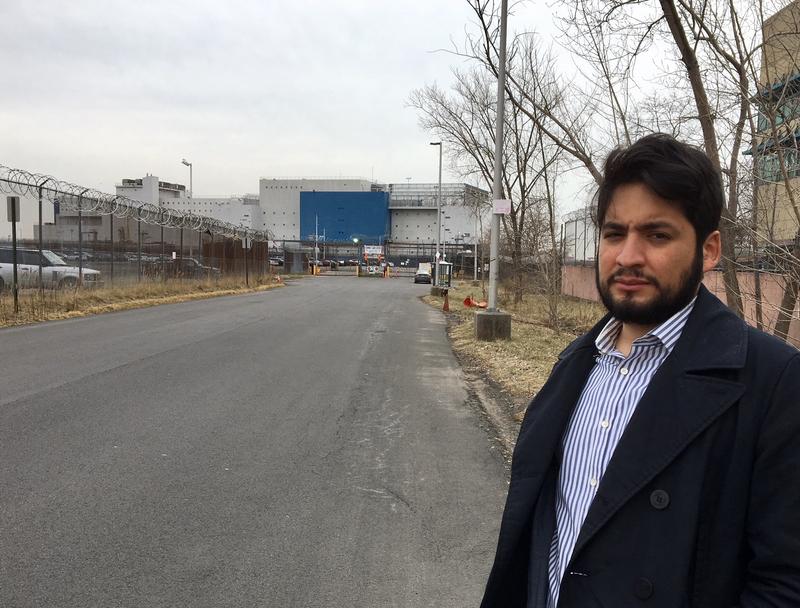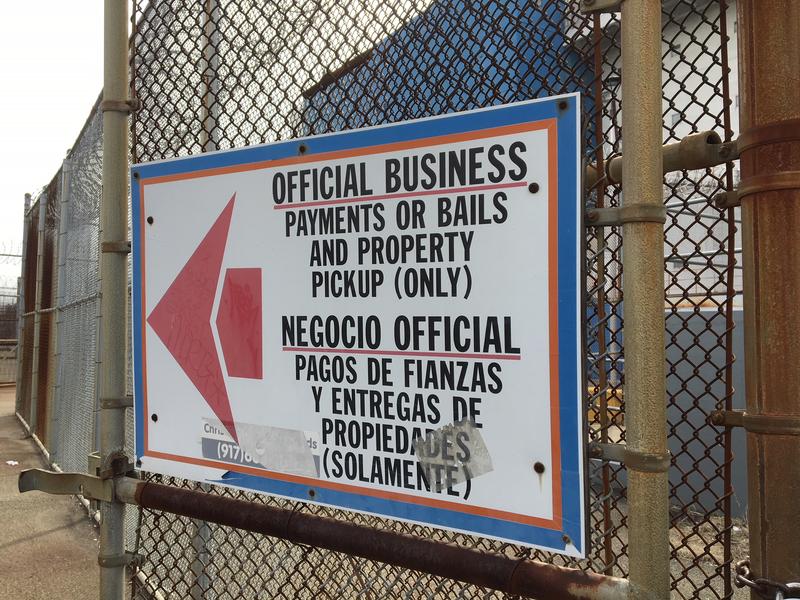
Rikers is the most famous jail complex in New York City. But the Vernon C. Bain Correctional Center is certainly the oddest: a floating jail in the East River at the very edge of the South Bronx. It's commonly called The Boat.
Built in the 1990s to alleviate overcrowding at Rikers, The Boat can house about 800 male inmates. Some are serving short sentences. But many others go there when they can't afford to pay bail in a courthouse. When a family member or friend goes to pay bail for them, the process is just as convoluted as getting to this isolated location far from any subway, in an industrial zone beyond the Hunts Point Market.
One morning in March, a woman named Penny was in the tiny waiting room just off The Boat trying to pay bail for her boyfriend. He’d been arrested the night before. Penny didn't want to give her full name because she worried her boyfriend’s arrest could affect her professional reputation. She'd arrived at The Boat before the 8 a.m. bail office opened. But her boyfriend’s bail was $5000 and the ATM in the waiting room couldn’t dispense that much. Personal checks aren’t allowed. Only cashier’s checks, money orders or credit cards. So Penny took a bus to her bank and said she got back by 9 a.m.
"About 10:35 someone came to the window again," she said, referring to the clerks behind an old fashioned sliding window. "I went to the window and he said I have two other things to do, be patient. I’m still waiting."
There are no bathrooms or vending machines in the little waiting room. Just a few chairs, and only two other people were waiting that morning. Penny had given up on going to her Manhattan office and said she would work from home later, "cause I don't even know when I’m leaving here."
She called WNYC later to say she eventually paid bail at around 12:30 p.m.
Why the Long Wait?
Richard Jimenez works for the Bronx Freedom Fund, a nonprofit that pays bail for low-income people if it’s $2000 or less. He said Penny's long morning was pretty typical at The Boat and the Department of Correction's three other jail complexes because DOC relies heavily on fax machines and lots of paper, not just computer files.
When going to pay bail for someone, he said, "They give you a clipboard and the form that they copied multiple times so it’s a little blurry." The DOC has a 15-step checklist that it says must be performed for each inmate before they're released. It includes checking for warrants, an interview and checking fingerprints. Once the clerks locate the right person and you pay, Jimenez showed how you sign a form that copies onto three other pieces of paper in different colors.
For the inmate trying to get out of jail, the process is even more aggravating. Jason Odome claimed it took about six hours to be released after his $1500 bail was posted last week. The Bronx Freedom Fund paid it because he couldn’t afford it. As he waited to leave, Odome said DOC staffers seemed overwhelmed.
"They was worried about getting the inmates, the inmates in intake, and finding them a housing area before they was worried about getting the bail inmates out — the free inmates that posted bail," he said. "So it was like a hard time in there."
Odome said he lost a total of four days of work after his arrest for a misdemeanor charge of violating a court order (he said he's innocent). The Bronx Freedom Fund said it wasn't contacted by his public defender until the Monday after his Saturday arrest, and paid for his bail that night.
A new city law requires the DOC to release inmates within five hours of payment, and that time period is supposed to shrink to three hours in October. The agency said inmates are discharged, on average, between two-to-five hours after bail is paid, barring extenuating circumstances.
"We understand that it can be frustrating to wait to see a loved one," said DOC Press Secretary Jason Kersten. "We want the bail and release process to move faster, too, and we will keep working to improve our end of the process."
Online Bail Payment
The city is planning to start an online system for paying bail, which is supposed to alleviate this problem, but the project is now a year-and-a-half behind schedule. Liz Glazer, director of the Mayor's Office for Criminal Justice, said the process took longer than expected because the current system for paying bail is so overly bureaucratic — different agencies rely on different computer systems and paperwork.
"Paper systems from the Department of Corrections, the Department of Finance, from the court system," she explained.
She said the online system is now expected to go into operation in April. Other cities, including Philadelphia, use online bail payment but Glazer said New York is the biggest and most complicated.
City councilman Rory Lancman said it doesn’t make sense that you can pay parking tickets and water bills online, but not bail. He noted that 85 percent of those with small amounts of bail, between $500-$1000, can't pay at arraignment. "So they’re spending whether it’s a day or a week at Rikers Island until their bail can be put together," he said. "It’s not rocket science and for the life of me I can’t understand why it’s taking so long."
Data analyzed by WNYC found about 14,000 misdemeanor cases in New York City that had to pay bail in 2017. We used records from the Office of Court Administration that were obtained and shared with us by the Marshall Project.*
This concern about sending low-income people to jail just because they can't pay bail is the reason why Lancman and Mayor Bill de Blasio support Gov. Andrew Cuomo's plan to do away with cash bail for non-violent offenses. It has much less support upstate and among prosecutors and Republicans. But unless the state legislature changes bail, all the city can do is make the current system more efficient.
With reporting from Allen Peng and WNYC's Data News Team, including Rhyne Piggott, Jenny Ye and Lylla Younes. Additional data analysis from Anna Flagg of The Marshall Project.
*Methodology: WNYC filtered the data to A, B and Unclassified Misdemeanors. We excluded cases that would not have continued after arraignment, including those that were dismissed or where the defendant pled. WNYC consulted with the state's Office of Court Administration and also with the Mayor’s Office for Criminal Justice, which does its own tracking. The bail data covers 2017.

